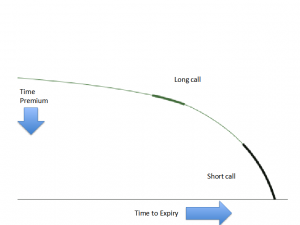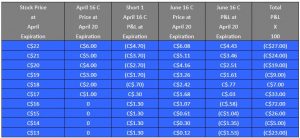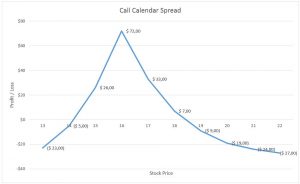Long Call Neutral Calendar Spreads

In previous submissions we’ve discussed put and call vertical spreads, “Bull Call and Bear Put Spreads”. This week Canadian investors will learn how to construct a calendar spread. The calendar spread is also known as a time spread or horizontal spread.
The calendar spread is typically constructed for a neutral outlook and is composed of one short call option with the simultaneous purchase of a longer-term option of the same strike and underlying security. The longer-term option will naturally have more time premium than the shorter duration call option and therefore is a debit-spread and requires a premium to purchase.
The calendar spread has as a near-term neutral to slightly bearish forecast (short call), while also having a longer-term bullish forecast (long call). The goal is to take advantage of the faster time decay (theta) of a near-term short call to offset part of the cost of the longer-term long call. In this case we use a higher volatility for the near-term call and a lower volatility for the long-term call. The choice of the at-the-money strike prices relative to underlying price makes the strategy neutral, while choosing out-of-the money strikes makes it more bullish. In both of these scenarios the options are composed entirely of time value and have no intrinsic value.
The maximum loss, provided the spread is closed out at the expiration of the front-month call, is the net debit paid for the spread. This loss would occur if the underlying declined enough that both options expired worthless, or if the case where the underlying rose enough that both options went deep in-the-money and traded at their intrinsic value only with no time value. Should the investor choose not to close out the entire position at the front month expiry then the investor is left with a long call option position in the long-term option and the loss is limited to the net premium paid.
The maximum gain at the near-term expiration occurs when the underlying is at the strike of the expiring short call option if the entire position is closed out. Should the investor let the short call expire worthless and leave the long call open then the maximum gain is unlimited.
Now that we understand the risks and rewards we can look at the most ideal opportunities for the calendar. Theta or time-decay is steepest in the last 30 days to expiry. Since we want to take advantage of this time-decay, the investor should sell the front-month option approximately 4-6 weeks prior to expiry in order to capture the sweet spot of higher premium levels and the oncoming steeper slope of near-term time-decay.
Let’s look at an example:
BB (Blackberry Limited) is currently trading at 16.49 as of March 9, 2018 The April 20 expiry is 40 days away. The investor sells a April 20 ATM 16 Call at C$1.30 with volatility of that option at 47.35% while simultaneously purchasing a June 16 call for C$1.65 with volatility at 41.64%. The cost of the position is C$1.30-C$1.65=$C.35 debit

Note that the price of the June 16 call at April expiration is estimated from a P&L calculator and is subject to changes in implied volatility and other factors. The assumption here is that the June 16 call is trading at the same volatility of 41.64 %. The numbers are provided solely for the sake of demonstration and to give the reader a general perception of the risks and rewards associated with this spread.
As seen from the table the profits are limited to a narrow range around the strike price of the option.

The main goal of a long call calendar is to achieve a lower purchase price for the long option than simply buying the long call outright. Theta has a positive impact in the early part of this strategy as the short option is subject to greater time decay. Increases in implied volatility will have a positive affect due to the long option being more sensitive to changes in volatility.
The investor needs to be tactical as the near term expiration approaches. The remaining long call can be held and will naturally appreciate if the stock price rises.
Should the underlying stand still or move lower the investor can choose to close the position or sell another call, if another near term option is available (monthly or weekly’s).
Final thoughts: early assignment is always a possibility with American style options, which would leave you short stock and an increase in margin, but the investor is covered somewhat by the long call should the stock move higher overnight. In this instance it is likely best to close the position as soon as possible.
It is essential to point out that this strategy needs to be actively managed, so it is only suitable for investors with ample options trading experience.
CEO
Grigoletto Financial Consulting
Alan Grigoletto is CEO of Grigoletto Financial Consulting. He is a business development expert for elite individuals and financial groups. He has authored financial articles of interest for the Canadian exchanges, broker dealer and advisory communities as well as having written and published educational materials for audiences in U.S., Italy and Canada. In his prior role he served as Vice President of the Options Clearing Corporation and head of education for the Options Industry Council. Preceding OIC, Mr. Grigoletto served as the Senior Vice President of Business Development and Marketing for the Boston Options Exchange (BOX). Before his stint at BOX, Mr. Grigoletto was a founding partner at the investment advisory firm of Chicago Analytic Capital Management. He has more than 35 years of expertise in trading and investments as an options market maker, stock specialist, institutional trader, portfolio manager and educator. Mr. Grigoletto was formerly the portfolio manager for both the S&P 500 and MidCap 400 portfolios at Hull Transaction Services, a market-neutral arbitrage fund. He has considerable expertise in portfolio risk management as well as strong analytical skills in equity and equity-related (derivative) instruments. Mr. Grigoletto received his degree in Finance from the University of Miami and has served as Chairman of the STA Derivatives Committee. In addition, He is a steering committee member for the Futures Industry Association, a regular guest speaker at universities, the Securities Exchange Commission, CFTC, House Financial Services Committee and IRS.
The information provided on this website, including financial and economic data, quotes and any analysis or interpretation thereof, is provided solely for information purposes and shall not be construed in any jurisdiction as providing any advice or recommendation with respect to the purchase or sale of any derivative instrument, underlying security or any other financial instrument or as providing legal, accounting, tax, financial or investment advice. Bourse de Montréal Inc. recommends that you consult your own advisors in accordance with your needs before making decision to take into account your particular investment objectives, financial situation and individual needs.
All references on this website to specifications, rules and obligations concerning a product are subject to the rules, policies and procedures of Bourse de Montréal Inc. and its clearinghouse, the Canadian Derivatives Clearing Corporation, which prevail over the content of this website. Although care has been taken in the preparation of the documents published on this website, Bourse de Montréal Inc. and/or its affiliates do not guarantee the accuracy or completeness of the information published on this website and reserve the right to amend or review, at any time and without prior notice, the content of these documents. Neither Bourse de Montréal Inc. nor any of its affiliates, directors, officers, employees or agents shall be liable for any damages, losses or costs incurred as a result of any errors or omissions on this website or of the use of or reliance upon any information appearing on this website.
BAX®, CADC®, CGB®, CGF®, CGZ®, LGB®, MX®, OBX®, OGB®, OIS-MX®, ONX®, SCF®, SXA®, SXB®, SXF®, SXH®, SXM®, SXO®, SXY®, and USX® are registered trademarks of the Bourse. OBW™, OBY™, OBZ™, SXK™, SXJ™, SXU™, SXV™, Montréal Exchange and the Montréal Exchange logo are trademarks of the Bourse. All other trademarks used are the property of their respective owners.
© 2024 Bourse de Montréal Inc. All Rights Reserved.
